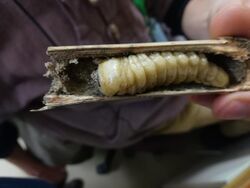Biology:Cacosceles newmannii
| Cacosceles newmannii | |
|---|---|

| |
| Cacosceles newmannii larva in a sugarcane stalk | |
| Scientific classification | |
| Domain: | Eukaryota |
| Kingdom: | Animalia |
| Phylum: | Arthropoda |
| Class: | Insecta |
| Order: | Coleoptera |
| Infraorder: | Cucujiformia |
| Family: | Cerambycidae |
| Genus: | Cacosceles |
| Species: | C. newmannii
|
| Binomial name | |
| Cacosceles newmannii Thomson, 1877
| |
| Synonyms | |
| |
Cacosceles newmannii is a species of longhorned beetle in the family Cerambycidae native to Southern Africa (Mozambique, Eswatini and South Africa[1] ). Its natural host plants have not yet been fully determined, but may include species from the family Myrtaceae,[1][2] and it has started to become a pest of sugarcane crops. It is assumed that its life cycle lasts two years, during which the larvae feed on organic matter.[3]
Adults emerge and mate in summer. Their lifespan is estimated to be between one and two months.[3] Both males and females show marked sexual dimorphism.[1] Males are characterized by very long, asymmetrical mandibles (the left mandible has a preapical internal tooth), while female mandibles are much shorter and thicker.[1][3] Males exhibit a broad tomentose groove along the basal half of the middle and posterior tibiae (fourth segment of the leg of an insect), which is absent in females. Males are generally smaller than females. In this species, fights were regularly observed between males.
Larvae of Cacosceles newmannii were found in 2015 in sugarcane crops in KwaZulu-Natal province in South Africa. The larvae can tunnel in the lower part of the cane stalk 8 to 20 cm upwards, but are mostly found in the underground section of the stems, at root level.[4]
The beetle has been used as a model for studying arthropod respiratory structures, with tracheal volume studied in 3D using X-ray micro-tomography scanning living larvae sedated with sevoflurane.[5] This work showing the tracheal structures in detail, and also showing tracheal oxygen supply capacity increases during development at a comparable, or even higher rate than metabolic demand.[6]
References
- ↑ 1.0 1.1 1.2 1.3 Ferreira, G. W. Santos (1980). The Parandrinae and the Prionae of Southern Africa (Cerambycidae, coleoptera). Bloemfontein: Nasionale Museum. ISBN 978-0-620-03937-6. OCLC 8766257. https://www.worldcat.org/oclc/8766257.
- ↑ Javal, Marion; Thomas, Saskia; Barton, Madeleine; Gillespie, Denise; Conlong, Desmond; Terblanche, John (2018-08-15). Understanding the recent invasion of Cacosceles newmannii (Coleoptera: Cerambycidae) into sugarcane from a thermal perspective. https://www.researchgate.net/publication/330900814.
- ↑ 3.0 3.1 3.2 Way, M.J.; Conlong, D.E.; Rutherford, R.S.; Sweby, D.L.; Gillespie, D.Y.; Stranack, R.A.; Lagerwall, G; Grobbelaar, E et al. (2017). "Cacosceles (Zelogenes) newmannii (Thomson) (Cerambycidae:Prioninae), a new pest in the South African sugarcane industry.". Proc S Afr Sug Technol Ass 90: 62–65. https://www.cabdirect.org/cabdirect/abstract/20183262271.
- ↑ Javal, M; Thomas, S; Barton, M.G.; Gillespie, D; Conlong, D.E.; Terblanche, J.S. (2018). "Understanding the recent invasion of Cacosceles newmannii (Coleoptera: Cerambycidae) into sugarcane from a thermal perspective.". Proc S Afr Sug Technol Ass 91: 66–69. https://www.cabdirect.org/cabdirect/abstract/20193314017.
- ↑ Lehmann, Philipp; Javal, Marion; Plessis, Anton Du; Tshibalanganda, Muofhe; Terblanche, John S. (2021). "X-ray micro-tomographic data of live larvae of the beetle Cacosceles newmannii" (in en). Gigabyte 2021: 1–8. doi:10.46471/gigabyte.18. https://gigabytejournal.com/articles/18.
- ↑ Lehmann, Philipp; Javal, Marion; Plessis, Anton Du; Terblanche, John S. (2021-04-01). "Using µCT in live larvae of a large wood-boring beetle to study tracheal oxygen supply during development" (in en). Journal of Insect Physiology 130: 104199. doi:10.1016/j.jinsphys.2021.104199. ISSN 0022-1910. PMID 33549568.
Wikidata ☰ Q14840899 entry
 |

